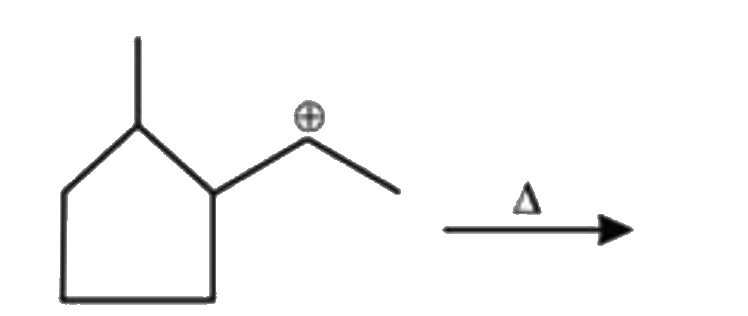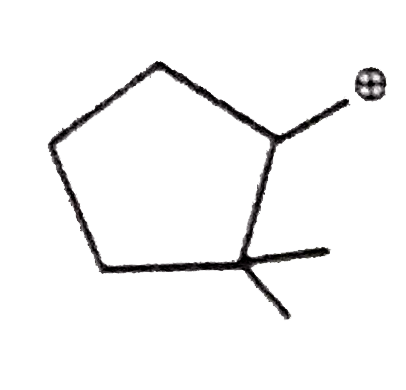Carbocations are planar species.
Step-by-Step Solution:
1. Understanding Carbocations:
- A carbocation is a positively charged carbon atom that has only six electrons in its valence shell, making it electron-deficient.
2. Hybridization of Carbocations:
- Carbocations typically undergo sp² hybridization. This means that one s orbital and two p orbitals from the carbon atom mix to form three equivalent sp² hybrid orbitals.
3. Geometry of Carbocations:
- The sp² hybridization results in a trigonal planar geometry. In this arrangement, the three sp² hybrid orbitals are oriented 120 degrees apart in a plane, leading to a planar structure.
4. Counting Attached Atoms:
- For a carbocation, the carbon atom is bonded to three other atoms (which can be hydrogen or carbon atoms) and has no lone pairs. Thus, the total number of attached atoms is 3.
5. Determining Hybridization:
- Using the hybridization formula:
- Hybridization = (Number of attached atoms + Number of lone pairs)
- For a carbocation: 3 (attached atoms) + 0 (lone pairs) = 3
- This indicates sp² hybridization.
6. Conclusion:
- Since carbocations are sp² hybridized and have a trigonal planar structure, they are indeed planar species. Therefore, the statement "Carbocations are planar species" is true.
---
- A carbocation is a positively charged carbon atom that has only six electrons in its valence shell, making it electron-deficient.
- Carbocations typically undergo sp² hybridization. This means that one s orbital and two p orbitals from the carbon atom mix to form three equivalent sp² hybrid orbitals.
- The sp² hybridization results in a trigonal planar geometry. In this arrangement, the three sp² hybrid orbitals are oriented 120 degrees apart in a plane, leading to a planar structure.
- For a carbocation, the carbon atom is bonded to three other atoms (which can be hydrogen or carbon atoms) and has no lone pairs. Thus, the total number of attached atoms is 3.
- Using the hybridization formula:
- Hybridization = (Number of attached atoms + Number of lone pairs)
- For a carbocation: 3 (attached atoms) + 0 (lone pairs) = 3
- This indicates sp² hybridization.
- Since carbocations are sp² hybridized and have a trigonal planar structure, they are indeed planar species. Therefore, the statement "Carbocations are planar species" is true.
Topper's Solved these Questions
- BOOK - ICSECHAPTER - ORGANIC CHEMISTRY : SOME BASIC PRINCIPLES AND TECHNIQUES EXERCISE - FILL IN THE BLANK TYPE QUESTIONS46videos
ORGANIC CHEMISTRY : SOME BASIC PRINCIPLES AND TECHNIQUES
- BOOK - ICSECHAPTER - ORGANIC CHEMISTRY : SOME BASIC PRINCIPLES AND TECHNIQUES EXERCISE - ASSERTION - REASON TYPE QUESTIONS11videos
ORGANIC CHEMISTRY : SOME BASIC PRINCIPLES AND TECHNIQUES
- BOOK - ICSECHAPTER - ORGANIC CHEMISTRY : SOME BASIC PRINCIPLES AND TECHNIQUES EXERCISE - OBJECTIVE ( MULTIPLE CHOICE ) TYPE QUESTIONS142videos
ORGANIC CHEMISTRY : SOME BASIC PRINCIPLES AND TECHNIQUES
- BOOK - ICSECHAPTER - HYDROGENEXERCISE - NCERT TEXT-BOOK EXERCISE (With Hints and Solutions)53videos
HYDROGEN
- BOOK - ICSECHAPTER - REDOX REACTIONS (OXIDATION AND REDUCTION)EXERCISE - NCERT TEXT-BOOK. EXERCISES ((With Hints and Solutions)69videos
REDOX REACTIONS (OXIDATION AND REDUCTION)
Similar Questions
Assertion : Carbocation are planar in nature.
Reason : Carbocations are sp2 hybridised.View SolutionReaction intermdiates are short lived species and are highly reactive. They are formed by heterolytic and homolytic bond fission. There are various types of reaction intermediates in which the most important are carbocation , carbanion and free radical.
Carbocation is an organic species in which carbon have positive charge and six electrons in its outermost shell. The stability of carbocation can be increased by positive inductive effect, hyperconjugation and delocalisation. If α-atom with respect to carbocation has one or more lone pair of electron then lone pair of electron strongly stabilises the carbocation due to octet completion.
Species in which carbon have negative charge is called carbanion. Carbanion carries three bond pairs and one lone pair. The stability of carbanion can be increased by negative inductive effect, negative mesomeric effect and delocalisation.
Free radical is a species which have seven electrons in its outermost shell. The stability of free radical can be increased by hyperconjugation and delocalisation.
The stability order of following carbocations is
 View Solution
View Solution
Knowledge Check
- Question 1 - Select One
Stability of alkyl carbocations can be explained by
Ainductive effect onlyBhyperconjugation onlyCboth inductive effect and hyperconjugationDelectromeric effect only - Question 2 - Select One
Assertion: - 3∘ carbocations are more stable than 1∘ and 2∘ carbocations.
Reason :- The+I effect of alkyl groups decreases the magnitude of positive charge to the maximum possible extent in a 3∘ carbocationAIf both Assertion and Reason are CORRECT and Reason is the CORRECT explanation of the Assertion.BIf both Assertion and Reason are CORRECT but Reason is not the CORRECT explanation of the Assertion.CIf Assertion is CORRECT but Reason is INCORRECT.DIf Assertion is INCORRECT but Reason is CORRECT.
Which of the following in the rearranged in the rearranged more stable carbocation of the given species?
 View Solution
View SolutionWhich of the following is the arranged more stable carbocation of the given species ?
CH3−CH3∣C∣CH3−⊕CH−CH3→View SolutionSelect triangular planar species among the following:
View SolutionHow many more stable carbocations are possible after rearrangement in the following carbocation.
 View Solution
View SolutionWhenever an intermediate carbocation is formed in reaction it may rearranges.
Only those carbocation will rearrange which can produce more stable species . It can be done either by :
(i) Shifting of H, alkyl , aryl, bond (1,2-shifting )
(ii) Ring expansion
(iii) Ring contraction
Most stable rearranged carbocation is is View Solution
is View SolutionA tertiary butyl carbocation is more stable than isopropyl carbocation. Justify.
View Solution
